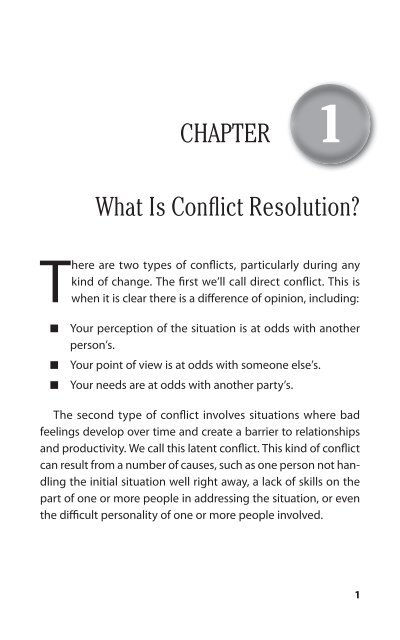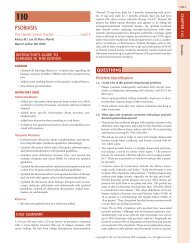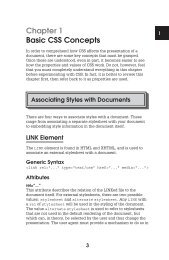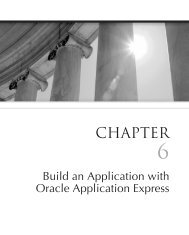CHAPTER What Is Conflict Resolution?
CHAPTER What Is Conflict Resolution?
CHAPTER What Is Conflict Resolution?
Create successful ePaper yourself
Turn your PDF publications into a flip-book with our unique Google optimized e-Paper software.
<strong>CHAPTER</strong> 1<br />
<strong>What</strong> <strong>Is</strong> Confl ict <strong>Resolution</strong>?<br />
There are two types of confl icts, particularly during any<br />
kind of change. The fi rst we’ll call direct confl ict. This is<br />
when it is clear there is a diff erence of opinion, including:<br />
■ Your perception of the situation is at odds with another<br />
person’s.<br />
■ Your point of view is at odds with someone else’s.<br />
■ Your needs are at odds with another party’s.<br />
The second type of confl ict involves situations where bad<br />
feelings develop over time and create a barrier to relationships<br />
and productivity. We call this latent confl ict. This kind of confl ict<br />
can result from a number of causes, such as one person not handling<br />
the initial situation well right away, a lack of skills on the<br />
part of one or more people in addressing the situation, or even<br />
the diffi cult personality of one or more people involved.<br />
1
2 ➜ PERFECT PHRASES FOR CONFLICT RESOLUTION<br />
Why Do We Avoid Confl ict?<br />
At some point, everyone avoids confl icts at work, for reasons<br />
both good and bad. Think of a confl ict you are currently avoiding.<br />
Perhaps the confl ict has been lingering for a while, or maybe<br />
you think you can continue to do your work without resolving<br />
it. <strong>What</strong>ever the case, something about this particular confl ict is<br />
making you avoid getting it resolved. Some possible causes for<br />
avoiding resolution are that the confl ict is:<br />
■ Too risky. You believe there is too much political risk to<br />
address it. A poorly handled confl ict could result in fallout<br />
that will damage a project, a task, or even your career.<br />
■ Unpleasant. It is just hard.<br />
■ Too personal. You may think that the issue is not work<br />
related.<br />
■ Diffi cult to control. You do not have confi dence you can<br />
control yourself. Or maybe the other party has a history of<br />
being explosive and you think you don’t have the skills to<br />
manage the situation.<br />
And as you may have experienced yourself, the tendency to<br />
avoid confl ict is particularly high when dealing with latent confl<br />
icts. Direct confl icts easily burst into the open and require a<br />
solution, whether we like it or not.<br />
These reasons for avoidance are all real and valid, as are many<br />
others. This book will help you overcome these and other obstacles<br />
and fi nd an approach that will enable you to address confl ict<br />
productively and professionally.
Can Confl ict Be Resolved?<br />
WHAT IS CONFLICT RESOLUTION? ➜<br />
We have yet to run across an organization where all confl ict is<br />
resolved. Confl ict ebbs and fl ows in relationships in organizations.<br />
In fact, if we saw no confl ict during change in an organization<br />
(and as we all know they are continuously changing!), we<br />
would suspect the organization to be dying or already dead! The<br />
emotional exchange of ideas and perceptions is a natural part of<br />
people working together.<br />
Employees at all levels must continue working even when<br />
confl icts and ambiguities exist. Of course, there are some work<br />
confl ict situations that can be addressed through a short dialogue<br />
to clear up misunderstandings. Many others, however,<br />
take more work. They require more energy, a willingness to<br />
revisit the issue, and a personal commitment to working things<br />
out in the long term.<br />
If you are looking at resolution as all parties being completely<br />
happy with the outcome, then resolution is not attainable in<br />
most situations. Often, one person will be happy and another<br />
not. Partnerships may not be even; there may be a clear hierarchy<br />
between, for example, boss and subordinate or customer<br />
and supplier and the party in power just decides. Even if there<br />
is a more balanced partnership, it can take a lot of eff ort and<br />
time to create a “win/win.” We don’t always have the energy<br />
and time to approach it this way. Other times a confl ict—particularly<br />
latent confl icts—drags on, sometimes even a long time.<br />
We hope it dissipates by itself—and sometimes it does, either<br />
because the situation has changed (again), key players change,<br />
or it may just become less important due to new priorities or a<br />
diff erent mood (diff erent emotions) of the main parties.<br />
3
4 ➜ PERFECT PHRASES FOR CONFLICT RESOLUTION<br />
Rules of Engagement<br />
<strong>What</strong> does it take to successfully resolve confl ict?<br />
1. Confl ict <strong>Resolution</strong> <strong>Is</strong> Not for the Faint of Heart<br />
As a fi rst step in approaching confl ict resolution, look honestly<br />
at yourself to see whether you have what it takes to address confl<br />
ict. Attributes of a good confl ict handler include:<br />
■ Courage. Confl ict always involves potential misinterpretation<br />
and hurt feelings. It takes courage to walk calmly and deliberately<br />
through the ambiguity and try to resolve it.<br />
■ Balancing your interests with the interests of others. Ultimately,<br />
you must care about the other person and her or her<br />
point of view to resolve confl ict. If you focus too much on yourself,<br />
you are being infl exible. Too much focus on the other party,<br />
on the other hand, means you overlook your own needs. It takes<br />
a balanced view.<br />
■ Thinking on your feet. Being prepared is important. However,<br />
don’t expect to have your conflict resolution plan all<br />
worked out and be able to stick with it. Humans are unpredictable,<br />
even the ones we know the best, so plan on adjusting your<br />
plan.<br />
■ Letting go of the “resolution.” To be eff ective in confl ict,<br />
one must adopt the mind-set of living in the state of ambiguity.<br />
Many times, you will have to live with an ongoing subtext of<br />
disagreement until sometime in the future when the issue may<br />
be resolved. Then again, it may never be resolved, or it may be
WHAT IS CONFLICT RESOLUTION? ➜<br />
resolved to the satisfaction of the other person but not you. The<br />
bottom line is that you must accept that confl ict will always exist,<br />
while a completely satisfying resolution may not.<br />
2. Know When to Give in and When to Hold<br />
Your Ground<br />
A simple way to avoid unnecessary confl ict and to only fi ght for<br />
your point of view when necessary is to think about how much<br />
interest you have in the outcome of a particular confl ict compared<br />
to how much interest the other party has. Using these two<br />
dimensions, you can easily decide how to approach the confl ict:<br />
■ Low interest to you, low interest to the other party:<br />
Forget it. This is not worth debating.<br />
■ Low interest to you, high interest to the other party:<br />
Give in. Why turn it into a fi ght if you don’t really care<br />
about it?<br />
■ High interest to you, low interest to the other party:<br />
Advocate. In situations where the outcome aff ects you<br />
more than the other person or people, be strong and<br />
advocate your position.<br />
■ High interest to you, high interest to the other party:<br />
Collaborate. The only way to come up with a productive<br />
solution is for both parties to work together. These are<br />
also the situations that can become the most contentious<br />
because both parties care so much about the results.<br />
5
6 ➜ PERFECT PHRASES FOR CONFLICT RESOLUTION<br />
3. Balance Cooperation and Advocacy<br />
The central art of handling confl ict is balancing being cooperative<br />
while at the same time advocating for your point of view.<br />
How direct should you be? If you are too passive, you will focus<br />
too much on making the other party happy at your expense or<br />
at the expense of the business issue. If you are too aggressive,<br />
you wind up focusing more on getting your way than on the<br />
other party’s feelings and point of view. When you are aggressive,<br />
you might also be blaming the other person for the problem.<br />
The challenge is to fi nd the middle ground: being assertive.<br />
This means to encourage and support the other person’s openness<br />
while advocating your point of view. It means taking both<br />
your and the other person’s thoughts, feelings, and wants into<br />
account.<br />
These phrases will help you know which part of the spectrum<br />
you are on:<br />
Passive<br />
■ <strong>What</strong>ever you do is OK with me.<br />
■ It doesn’t matter.<br />
■ <strong>What</strong>ever.<br />
■<br />
Aggressive<br />
You always .<br />
■ You never .<br />
■ <strong>What</strong> is the matter with you?
Assertive<br />
WHAT IS CONFLICT RESOLUTION? ➜<br />
■ I hear you saying that . However, what I<br />
want/need is . The reason(s) I need this is/<br />
are . Does that make sense? Let’s see if we<br />
can come up with a mutually workable solution.<br />
■ I understand that you are having a problem with<br />
. I would like to make a request. The next<br />
time this happens, could we ?<br />
■ This doesn’t seem to be working for either of us. It is not<br />
working for me because . <strong>What</strong> would work<br />
better for me is . Would that work for you?<br />
4. Be Direct and Avoid Triangulation<br />
Talk to the person with whom you have the confl ict. While you<br />
may decide to speak to someone who is not involved for advice<br />
on how to handle a situation, asking that person to take sides or<br />
intervene on your behalf only creates more interpersonal problems.<br />
Such an action erodes trust and reduces the chance of<br />
future issues being resolved. (See the section on cultural aspects<br />
later in this chapter for further discussion.)<br />
5. Reduce Static<br />
<strong>What</strong> we call static is anything within a person or an environment<br />
that interferes with clear communication. It is the same<br />
concept as the static on the radio when you try to tune in to a<br />
station and can’t get good reception. The resulting noise is a<br />
distraction from the song you want to hear.<br />
7
8 ➜ PERFECT PHRASES FOR CONFLICT RESOLUTION<br />
Static can be in our environment as well as in our head. Some<br />
common examples of static are:<br />
■ Background noise<br />
■ Physical distractions—pain, hunger, or fatigue<br />
■ Jumping to solutions—moving too quickly to solve an<br />
issue, without considering the whole situation, can cause<br />
disruption<br />
■ Asking too many questions—if you are asking questions<br />
all the time and interrupting the talker, you may be overtaking<br />
the conversation<br />
■ Interruptions—other people, walking in from outside, can<br />
be static. Find out what they are looking for. <strong>Is</strong> it an emergency?<br />
Do they want advice? Do they just want someone<br />
to talk to? Depending on the situation, you should ask for<br />
a meeting at a more appropriate time.<br />
■ Your own mind—you can think much faster than you<br />
can speak! Your mind has extra bandwidth and naturally<br />
wanders away. So what can you do to help with that extra<br />
bandwidth? Make your conversation more interactive.<br />
Pause. Ask for your listener’s input. Check whether he or<br />
she has any questions.<br />
When discussing contentious issues, set up a time and place<br />
when you and your colleague can give the discussion your full<br />
attention. This will let both of you focus your mind and energy<br />
on the conversation.
Phases of Confl ict<br />
WHAT IS CONFLICT RESOLUTION? ➜<br />
All of the phrases in this book follow a four-step process to handle<br />
confl ict:<br />
1. Understand the issue<br />
2. Set a vision<br />
3. Explore alternatives<br />
4. Agree on action<br />
Following this simple structure increases your success in confl ict<br />
situations. With that said, it is hard to always follow it perfectly.<br />
It is meant as a guideline to address the key aspects of confl ict<br />
situations.<br />
Each of these four steps is further outlined below:<br />
Understand the <strong>Is</strong>sue<br />
Framing the beginning of the conversation as an opportunity<br />
to understand the issue, rather than as a fi ght or argument, will<br />
make it easier to begin the resolution process. Here are the key<br />
elements of this step:<br />
■ Ask for a meeting: Before speaking with the person with<br />
whom you have a confl ict, ask for a meeting. It is always best<br />
if you and your colleague can focus on the issue without being<br />
disturbed. You may also want to prepare so you can handle the<br />
meeting eff ectively.<br />
9
10 ➜ PERFECT PHRASES FOR CONFLICT RESOLUTION<br />
You may not want to disclose any of the details of the topic<br />
of conversation in an e-mail or a phone call when setting up a<br />
meeting. Once you bring up the issue, the conversation starts.<br />
If both of you are not in a place or space to fully discuss it, the<br />
conversation can backfi re because neither of you can do justice<br />
to the complexity and emotions of the topic.<br />
Instead, try saying something like “I would like to meet with<br />
you to discuss an important issue.” If the other person asks you<br />
what that topic is, it is better to say something along the lines<br />
of “It would be best to discuss it when we can both focus on it.”<br />
This communicates that the topic is not quick, that it is important,<br />
and that it could be complicated and emotional, which<br />
helps ensure he or she sets up a time and place for such a conversation.<br />
In addition, he or she will be curious and come ready<br />
to listen.<br />
Here is an example:<br />
Employee: “Mary, I’d like to schedule a meeting with you to<br />
discuss an important issue.”<br />
Boss: “<strong>What</strong> is it?”<br />
Employee: “I’d rather talk about it when we both have time<br />
to talk with our full attention. When would you have thirty<br />
minutes?”<br />
Boss: “I need to know what it is so I can prepare.”<br />
Employee: “I understand that. However, if I open the conversation<br />
now it will just complicate things. Are you willing to trust<br />
me and we can take all the time we need at the meeting?”<br />
When the meeting begins, you will need to raise the issue.<br />
You will notice in our phrases we begin with raising the issue, the<br />
fi rst part of any confl ict resolution, which is often the hardest.
WHAT IS CONFLICT RESOLUTION? ➜<br />
■ Open discussion: It helps to fi nd a neutral or positive way to<br />
open the discussion such as talking about other things, business<br />
or personal.<br />
■ Share specifi cs: Make sure that you come to the discussion<br />
prepared. Have specifi c examples and cases in mind so you can<br />
help make the conversation concrete and prevent it from escalating<br />
into blaming and accusations.<br />
Raise the issue by being as specifi c as possible. Mention the<br />
specifi c situation(s) or events(s) that upset you. If you can identify<br />
behaviors, such as what the other person did or did not say or<br />
do, that is particularly helpful. This will help focus the conversation<br />
rather than the other person perceiving you as attacking<br />
him or her.<br />
■ Discuss impact: If possible, explain the impact the event<br />
had on you, the team, other people, the business, or customers.<br />
Again, this will help the other person understand that you are<br />
not raising this issue just to be diffi cult.<br />
■ Listen: A key part of understanding the issue is to understand<br />
the other person’s point of view. Ask questions. Be curious. Follow<br />
the guidelines later in this chapter on listening. This will go<br />
a long way toward building understanding and ultimately to<br />
resolving the confl ict.<br />
Set a Vision<br />
Before you decide to address a confl ict, you need to be very clear<br />
about what your objectives are in addressing it. Do you want to:<br />
■ Improve a relationship?<br />
■ Resolve a business issue?<br />
11
12 ➜ PERFECT PHRASES FOR CONFLICT RESOLUTION<br />
■ Assure better service quality or deliver best customer<br />
service?<br />
■ Promote yourself?<br />
■ Make future life at work easier?<br />
■ Get compliance with the process you are in charge of?<br />
Articulating a vision for the future, after you have explored<br />
the issue, will help both parties move beyond the past and into<br />
a more positive frame of mind.<br />
Explore Alternatives<br />
Once the vision is out on the table, both parties can openly<br />
discuss how to get there. The phrases at this stage are either<br />
questions to get the other person’s ideas on how to rectify the<br />
situation or your suggestions on how to do the same:<br />
■ How are you going to do it?<br />
■ How can I help?<br />
■ <strong>What</strong> ideas do you have to prevent this in the future?<br />
■ <strong>What</strong> could you do to make sure this doesn’t happen<br />
again?<br />
■ I’ll need a little time to process this before we talk some<br />
more.<br />
■ In the future could you include me on<br />
taking action?<br />
before<br />
■ For the next project, let’s meet when we start and clearly<br />
defi ne roles, responsibilities, and decision- making process.
WHAT IS CONFLICT RESOLUTION? ➜<br />
■ I might need to talk to if we cannot work this<br />
out.<br />
Use these types of questions or suggestions—or both—as your<br />
situation warrants.<br />
Agree on Action<br />
If you get this far, you are likely to get to agreement. The only<br />
exception would be if the two of you cannot agree on how to fi x<br />
the problem. If that is the case, you may want to ask for a chance<br />
to think it over and meet again. Or you may need to inform him<br />
or her of your intention to escalate the issue. <strong>What</strong>ever the case,<br />
make sure to end with being clear about who is going to do<br />
what.<br />
Handling Emotions<br />
The facts or fi gures are often not the problem in confl ict; the<br />
emotions are. Depending on the personalities, situations,<br />
power-diff erentials, and skills of each party, confl ict creates a<br />
wide range of personal emotional reactions.<br />
Take the situation of a diff erence of opinion with your manager<br />
about your performance. The facts may be unclear as to<br />
whether you have met your manager’s expectations. Expectations<br />
are subjective and may not have been outlined specifi -<br />
cally. In addition, your manager has more organizational power<br />
than you. Especially if it is a situation where money and career<br />
advancement are at stake, the emotions can begin to ratchet up.<br />
Fear, anxiety, and stress can build and create a barrier to<br />
clear communication. Blaming, avoidance, and/or arguing often<br />
13
14 ➜ PERFECT PHRASES FOR CONFLICT RESOLUTION<br />
ensue. The approaches in this book are meant to reduce emotions<br />
and create clarity and understanding.<br />
Strategies for Handling Negative Emotions<br />
There are several approaches you can use to reduce the negative<br />
emotions in yourself and others during confl ict. The following<br />
are some ideas and phrases you can use:<br />
■ Sit at the same side of the table. This reduces the psychological<br />
barrier of the table and opens up the communication.<br />
■ Delay: “Let’s talk about it later when we have more time to<br />
think it through.”<br />
■ Lower expectations: “I know you won’t like this but I think<br />
we need to talk about it anyway.”<br />
■ Start with the positive: “You are very good at<br />
however, .”<br />
■ Break the tension by being relaxed and personal: “I am so<br />
glad we are talking about this.” “You are really someone I<br />
trust to work this through with.”<br />
■ Include commonalities and points of agreements as you’re<br />
discussing the diff erences: “You are right we do need to<br />
work on . It is also getting clear from this conversation<br />
that we are doing pretty well with .”<br />
■ Acknowledge the other person’s diffi culty: “I see that this<br />
is a challenge for you.” “I hear that you are having a hard<br />
time with .”<br />
■ Take responsibility for your part in the problem: “I see now<br />
how I am contributing to this by doing .”
WHAT IS CONFLICT RESOLUTION? ➜<br />
■ Take responsibility for solving the problem: “Next time<br />
I .”<br />
■ Apologize, if necessary: “I am so sorry I create this problem.”<br />
“I apologize for inadvertently creating such reactions.”<br />
Counterproductive Confl ict Beliefs<br />
<strong>What</strong> comes fi rst, thoughts or feelings? The research on emotional<br />
intelligence shows that thoughts come fi rst. Imagine how<br />
it feels when someone you don’t like walks into your offi ce; you<br />
have a feeling of dread or stress. If you track back to what you<br />
were thinking when he or she walked in, you will realize that<br />
you had a negative thought, such as “Oh no,” or “I don’t want<br />
to deal with this right now.”<br />
Our thoughts can be our own worst enemy during confl ict.<br />
Some thoughts/beliefs that we have found to interfere with<br />
resolving confl ict include:<br />
■ ”It may resolve itself”—this creates a delay in resolving the<br />
issue and may even build a bigger problem.<br />
■ ”It is not important enough”—this thought minimizes the<br />
person and the issue, which may come back to haunt you.<br />
■ ”He or she will never understand”—this becomes a selffulfi<br />
lling prophecy.<br />
■ ”It is useless”—this is another self-fulfi lling prophecy.<br />
■ ”It’s not me, it is my boss’s job to handle this”—this puts<br />
the responsibility on someone else’s shoulders.<br />
■ ”We can’t have that conversation here”—having that conversation<br />
is just plain hard work and no one wants to do it.<br />
15
16 ➜ PERFECT PHRASES FOR CONFLICT RESOLUTION<br />
Listening<br />
Part of the frustration in any confl ict comes from feeling like the<br />
other person doesn’t understand. He or she is not listening.<br />
Lack of listening by either side escalates confl ict. Before you<br />
tell the other person you disagree or make your point yet again,<br />
try listening to him or her. Even a small bit of listening will go a<br />
long way to increase understanding and reduce confl ict.<br />
Should you think listening is for those who are not strong<br />
enough to take charge, take a cue from Jim Higgins, a former<br />
police offi cer. Jim worked for thirteen years in enforcement<br />
on the streets in New York, dealing with drug dealers, prostitutes,<br />
gambling, and domestic disputes across cultures and<br />
neighborhoods.<br />
We had the privilege of interviewing him about the secret to<br />
eff ective policing and de-escalating confl ict. <strong>Is</strong> it force? <strong>Is</strong> it psychology?<br />
<strong>Is</strong> it fear?<br />
Surprisingly, Jim said that none of those were the answer.<br />
Whether dealing with an angry tenant or a psychotic claiming<br />
his mother is a Russian spy, he says the secret is to “Listen. Mirror<br />
what people are saying. Try from the beginning to be understanding<br />
and kind. It calms people down. Once you start to act<br />
like a tough guy, you can’t go back and be understanding—it<br />
is too late.”<br />
So how can you do this?<br />
First, focus on the other person. In today’s busy world of a<br />
hundred e-mails a day, multiple work projects, and constant<br />
pressure, everyone is stressed. Help yourself focus by looking<br />
at the other person, taking notes about the conversation, turn-
WHAT IS CONFLICT RESOLUTION? ➜<br />
ing away from the computer, shutting off the monitor, closing<br />
e-mail. Focus your attention on him or her, not on yourself.<br />
Remember that there are always multiple levels of communication<br />
going on—the actual words, the tone of voice, and body<br />
language. Words are easiest, but even then you can be misled.<br />
Voice tone is not so much up for interpretation, but it is still<br />
important. For example, “Yeah, right” said in an agreeable tone is<br />
far diff erent than “Yeah, right” said in a sarcastic tone. The words<br />
are the same, but the change of tone makes a big diff erence.<br />
The same is true for many body postures, which can have<br />
multiple meanings. A good thing to keep in mind is the change<br />
of a body posture. For example, if we are talking and, in the middle<br />
of the conversation, I cross my arms, that posture change<br />
means something has probably changed in my perception of<br />
the conversation.<br />
Most important, explore the other person’s point of view.<br />
<strong>What</strong> is he or she talking about? Why are his or her beliefs what<br />
they are? Ask sincere questions to gain understanding so that<br />
you will be able to:<br />
■ Get more information on his or her point of view<br />
■ Communicate you care about how he or she sees things<br />
■ Move from the emotion-laden part of your brain to the<br />
rational side<br />
By asking questions, you can explore his or her point of view:<br />
■ Why do you think that?<br />
■ <strong>What</strong> makes you feel that way?<br />
17
18 ➜ PERFECT PHRASES FOR CONFLICT RESOLUTION<br />
■ <strong>What</strong> happened to give you that impression?<br />
■ <strong>What</strong> did I say that led you to that conclusion?<br />
You can also paraphrase what you heard to make sure you<br />
understand the other person’s point of view correctly. Such<br />
phrases as the following will help you mirror his or her words<br />
well:<br />
■ It sounds like you are saying . . .<br />
■ Do you mean . . .<br />
■ Let me make sure I understand you. You said . . .<br />
Culture and Confl ict<br />
Do you work in a culture in which people address confl icts or<br />
one in which people avoid confl icts? How do you know?<br />
For starters, consider your meetings. Are they animated,<br />
engaged, full of constructive dialogue? Do they include confl icting<br />
point of views and discussions about them? In this case, you<br />
may be in a culture that is open to confl ict.<br />
If your meetings are boring and usually just include the presentation<br />
facts, it may mean that the participants of the meeting<br />
have little in common and no overlapping responsibilities;<br />
however, often it is an indication for confl ict avoidance. Confl ictavoidance<br />
cultures have destroyed more value than any other<br />
single business behavior! Look at it this way: To have a healthy<br />
discourse and discuss new and opposing ideas is a key ingredient<br />
to innovation, business process improvements, and personal<br />
development. On the other side, if you don’t dare to bring up
WHAT IS CONFLICT RESOLUTION? ➜<br />
thought-provoking ideas, voice concern, or break with “common<br />
wisdom,” you, your department, and your company will<br />
continue to dwell in the “same old, same old.” Problems may be<br />
ignored until they blow up with a big bang. Often it is too late<br />
by then.<br />
<strong>Is</strong>sues of Power<br />
Managing conflict is difficult. When you add in important<br />
aspects of diversity, such as race, gender, sexual orientation, age,<br />
and culture, it can get even more complicated.<br />
When two people have many similarities, even if the confl ict<br />
is strong, there is a good possibility of resolving the confl ict successfully.<br />
The more diff erences there are between the two parties,<br />
the more complicated resolution gets.<br />
Amounts of organizational power are based on the groups<br />
people belong to. A simple example is level in the hierarchy. You<br />
have likely been supervised by someone and know how careful<br />
you need to be when diff erences of opinions or strong feelings<br />
occur. You might even have had the experience of not raising an<br />
important issue due to a concern that your manager wouldn’t<br />
understand you or would even punish you in some way for raising<br />
the issue. This is because your boss has more power than<br />
you.<br />
This may also be the case if you are from a diff erent culture or<br />
ethnic group or even sexual orientation than most people in the<br />
organization. When engaging the confl ict, you might not want<br />
to “rock the boat,” especially if you are trying to fi t in to a group<br />
while being the only person like yourself.<br />
19
20 ➜ PERFECT PHRASES FOR CONFLICT RESOLUTION<br />
How Do We Reduce Power Differences?<br />
Many executives report they wish they would get more pushback<br />
from their staff . They would like to be challenged and<br />
disagreed with. They purport to have “open door policies” and<br />
believe they are creating open climates where disagreements<br />
can be aired freely. Yet very few staff take them up on the off er.<br />
These leaders are either unaware of or unable to change the<br />
dynamic.<br />
Having power can be blinding. Thus the challenge in managing<br />
confl ict across diff erences is most signifi cant when you<br />
are in the more dominant powerful position. The more power<br />
you have (vis-à-vis group memberships), the more you need to<br />
exhibit the following behaviors:<br />
■ Be aware of power diff erences. In any confl ict situation, look<br />
at the group membership diff erences in the people involved.<br />
Consider race, culture, gender, age, sexual orientation, organizational<br />
level, and any other diff erence that has resonance within<br />
the organization. Might they be hesitant to speak up or to give<br />
in? Might they feel superior and listen less? For example, women<br />
may have to walk a fi ne line when presenting a diff erent opinion—they<br />
could be concerned about being perceived as not a<br />
team player or as too pushy. Men can be blunt and direct; while<br />
such behavior might be uncomfortable, it would be perceived as<br />
being “really upset” or regarding something “really important”<br />
rather than being pushy.<br />
■ Consider the impact of bias. Ask yourself what biases you<br />
might hold that will aff ect your behavior. For example, is it OK<br />
when a man pushes back but not when a woman does? Do you
WHAT IS CONFLICT RESOLUTION? ➜<br />
expect your employees to follow what you say just because you<br />
are the boss? Then consider how these biases might impact the<br />
outcome of the confl ict.<br />
■ Work hard to build relationships. Build relationships across<br />
diff erences by being genuinely interested in people who are different<br />
from you. Seek them out and inquire about their lives,<br />
perspectives, and experiences. Take extra time to explore their<br />
point of view. Building strong relationships will make it easier to<br />
discuss tough issues when they come up.<br />
21

















